Thinking small, being engaging, and having a sense of humor don't hurt. Those are a few of the traits of successful science crowdfunding efforts that emerge from a recent study that examined nearly 400 campaigns. But having a large network and some promotional skills may be more crucial.
Crowdfunding, raising money for a project through online appeals, has taken off in recent years for everything from making movies to producing water-saving gadgets. Scientists have tried to tap Internet donors, too, with mixed success. Some raised more than twice their goals, but others have fallen short of reaching even modest targets.
To determine what separates science crowdfunding triumphs from failures, a team led by science communications scholar Mike Sch?fer of the University of Zurich examined the content of the webpages for 371 recent campaigns.
Four traits stood out for those that achieved their goals, the researchers report in Public Understanding of Science. For one, they use a crowdfunding platform that specializes in raising money for science, and not just any kind of project. Although sites like Kickstarter take all comers, platforms such as Experiment.com and Petridish.org only present scientific projects. For another, they present the project with a funny video because good visuals and a sense of humor improved success. Most of them engage with potential donors, since projects that answered questions from interested donors fared better. And they target a small amount of money. The projects included in the study raised $4,000 on average, with 30% receiving less than $1,000. The more money a project sought, the lower the chance it reached its goal, the researchers found.
Other factors may also significantly influence a project's success, most notably, the size of a scientist's personal and professional networks, and how much a researcher promotes a project on their own. Those two factors are by far more critical than the content on the page. Crowdfunding can be part of researchers' efforts to reach the public, and people give because "they feel a connection to the person" who is doing the fundraising—not necessarily to the science.
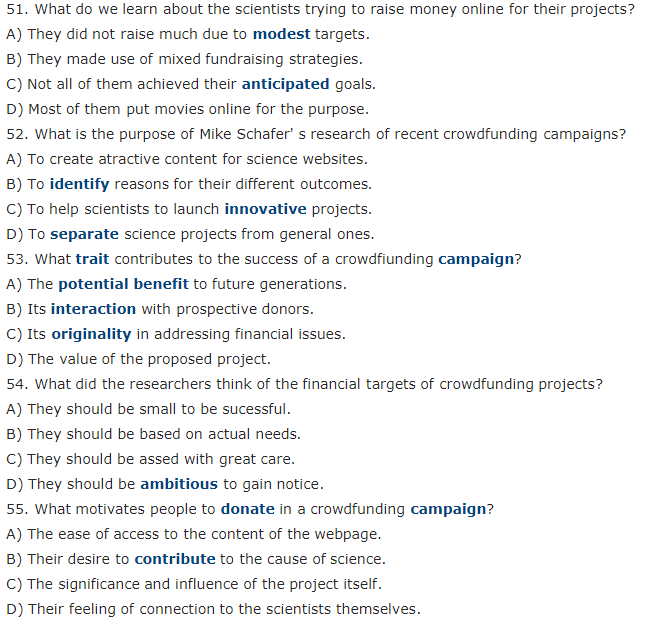
正确答案及解析
正确答案
CBBAD
解析
小小思考、积极参与和幽默感并没有什么坏处。这些是最近一项对近 400 项活动进行的研究中得出的成功科学众筹活动的一些特征。但是拥有庞大的网络和一些宣传技巧可能更为重要。
众筹,通过在线呼吁为一个项目筹集资金,近年来在从制作电影到生产节水小工具的方方面面都取得了成功。科学家们也试图利用互联网捐助者,但取得了不同的成功。有些人提出了两倍以上的目标,但其他人甚至连适度的目标都没有达到。
为了确定科学众筹的成功与失败的区别,由苏黎世大学科学传播学者 Mike Sch?fer 领导的一个团队检查了最近 371 个活动的网页内容。
研究人员在《公众对科学的理解》中报告说,对于那些实现目标的人来说,有四个特征脱颖而出。一方面,他们使用专门为科学筹集资金的众筹平台,而不仅仅是任何类型的项目。尽管像 Kickstarter 这样的网站吸引了所有人,但像 Experiment.com 和 Petridish.org 这样的平台只展示科学项目。另一方面,他们用一个有趣的视频展示了这个项目,因为良好的视觉效果和幽默感提高了成功率。他们中的大多数与潜在的捐助者接触,因为回答感兴趣的捐助者问题的项目进展得更好。他们的目标是少量资金。研究中包含的项目平均筹集了 4,000 美元,其中 30% 的收入低于 1,000 美元。研究人员发现,一个项目寻求的资金越多,它实现目标的机会就越低。
其他因素也可能显着影响项目的成功,最显着的是科学家个人和专业网络的规模,以及研究人员自己推动项目的程度。这两个因素远比页面上的内容重要。众筹可以成为研究人员接触公众的努力的一部分,人们捐款是因为“他们感到与进行筹款的人有联系”——不一定与科学有关。
你可能感兴趣的试题
Textbooks represent an 11 billion dollar industry, up from $8 billion in 2014. Textbook publisher Pearson is the largest publisher -- of any kind -- in the world.
It costs about $1 million to create a new textbook. A freshman textbook will have dozens of contributors, from subject-matter experts through graphic and layout artists to expert reviewers and classroom testers. Textbook publishers connect professors, instructors and students in ways that alternatives, such as open e-textbooks and open educational resources, simply do not. This connection happens not only by means of collaborative development, review and testing, but also at conferences where faculty regularly decide on their textbooks and curricula for the coming year.
It is true that textbook publishers have recently reported losses, largely due to students renting or buying used print textbooks. But this can be chalked up to the excessively high cost of their books -- which has increased over 1,000 percent since 1977. A restructuring of the textbook industry may well be in order. But this does not mean the end of the textbook itself.
While they may not be as dynamic as an iPad, textbooks are not passive or lifeless. For example, over the centuries, they have simulated (模拟) dialogues in a number of ways. From 1800 to the present day, textbooks have done this by posing questions for students to answer inductively (归纳性地). That means students are asked to use their individual experience to come up with answers to general questions. Today's psychology texts, for example, ask: "How much of your personality do you think you inherited?" while ones in physics say: "How can you predict where the ball you tossed will land?"
Experts observe that "textbooks come in layers, something like an onion." For an active learner, engaging with a textbook can be an interactive experience. Readers proceed at their own pace. They "customize" their books by engaging with different layers and linkages. Highlighting, Post-It notes, dog-ears and other techniques allow for further customization that students value in print books over digital forms of books.
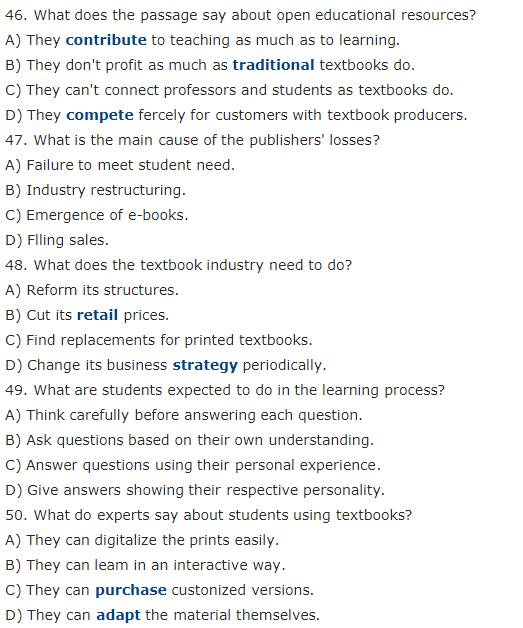
- 查看答案
When we think of animals and plants, we have a pretty good way of dividing them into two distinct groups: one converts sunlight into energy and the other has to eat food to make its energy. Well, those dividing lines come crashing down with the discovery of a sea slug (海蛞蝓) that's truly half animal and half plant. It's pretty incredible how it has managed to hijack the genes of the algae (藻类) on which it feeds.
The slugs can manufacture chlorophyll, the green pigment (色素) in plants that captures energy from sunlight, and hold these genes within their body. The term kleptoplasty is used to describe the practice of using hijacked genes to create nutrients from sunlight. And so far, this green sea slug is the only known animal that can be truly considered solar-powered, although some animals do exhibit some plant-like behaviors. Many scientists have studied the green sea slugs to confirm that they are actually able to create energy from sunlight.
In fact, the slugs use the genetic material so well that they pass it on to their future generations. Their babies retain the ability to produce their own chlorophyll, though they can't generate energy from sunlight until they've eaten enough algae to steal the necessary genes, which they can't yet produce on their own.
"There's no way on earth that genes from an alga should work inside an animal cell," says Sidney Pierce from the University of South Florida. "And yet here, they do. They allow the animal to rely on sunshine for its nutrition. So if something happens to their food source, they have a way of not starving to death until they find more algae to eat."
The sea slugs are so good at gathering energy from the sun that they can live up to nine months without having to eat any food. They get all their nutritional needs met by the genes that they've hijacked from the algae.
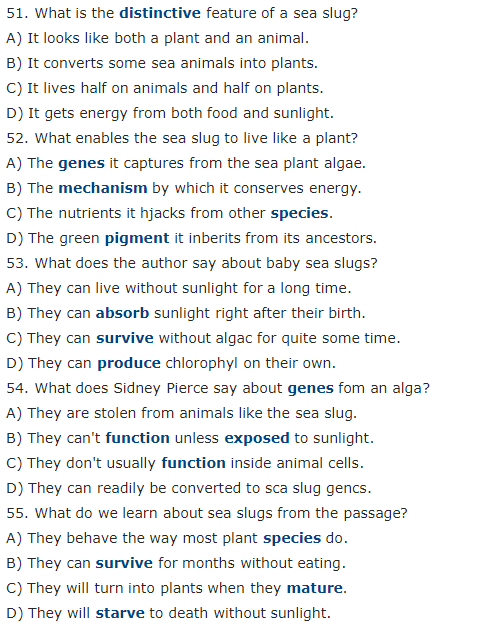
- 查看答案
For this part, you are allowed 30 minutes to write a letter to a foreign friend who wants to teach English in China. Please recommend a city to him. You should write at least 120 words but no more than 180 words.
- 查看答案
A) We've always been a hands-on, do it-yourself kind of nation. Ben Franklin, one of America's founding fathers, didn't just invent the lightning rod. His creations include glasses, innovative stoves and more.
B) Franklin, who was largely self-taught, may have been a genius, but he wasn't really an exception when it comes to American making and creativity.
C) The personal computing revolution and philosophy of disruptive innovation of Silicon Valley grew, in part, out of the creations of the Homebrew Computer Club, which was founded in a garage in Menlo Park, California, in the mid-1970s. Members-including guys named Jobs and Wozniak-started making and inventing things they couldn't buy.
D) So it's no surprise that the Maker Movement today is thriving in communities and some schools across America. Making is available to ordinary people who aren't tied to big companies, big defense labs or research universities. The maker philosophy echoes old ideas advocated by John Dewey, Montessori, and even ancient Greek philosophers, as we pointed out recently.
E) These maker spaces are often outside of classrooms, and are serving an important educational function. The Maker Movement is rediscovering learning by doing, which is Dewey's phrase from 100 years ago. We are rediscovering Dewey and Montessori and a lot of the practices that they pioneered that have been forgotten or at least put aside. A maker space is a place which can be in a school, but it doesn't look like a classroom. It can be in a library. It can be out in the community. It has tools and materials. It's a place where you get to make things based on your interest and on what you, re learning to do.
F) Ideas about learning by doing have struggled to become mainstream educationally, despite being old concepts from Dewey and Montessori, Plato and Aristotle, and in the American context, Ralph Emerson, on the value of experience and self-reliance. It's not necessarily an efficient way to learn. We learn, in a sense, by trial and error. Learning from experience is something that takes time and patience. It's very individualized. If your goal is to have standardized approaches to learning, where everybody learns the same thing at the same time in the same way, then learning by doing doesn't really fit that mold anymore. It's not the world of textbooks. It's not the world of testing.
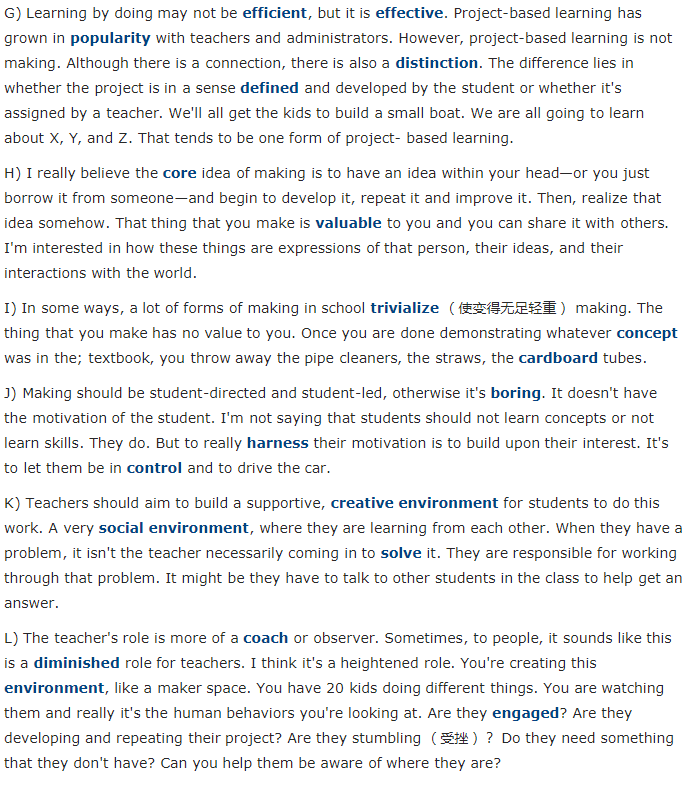
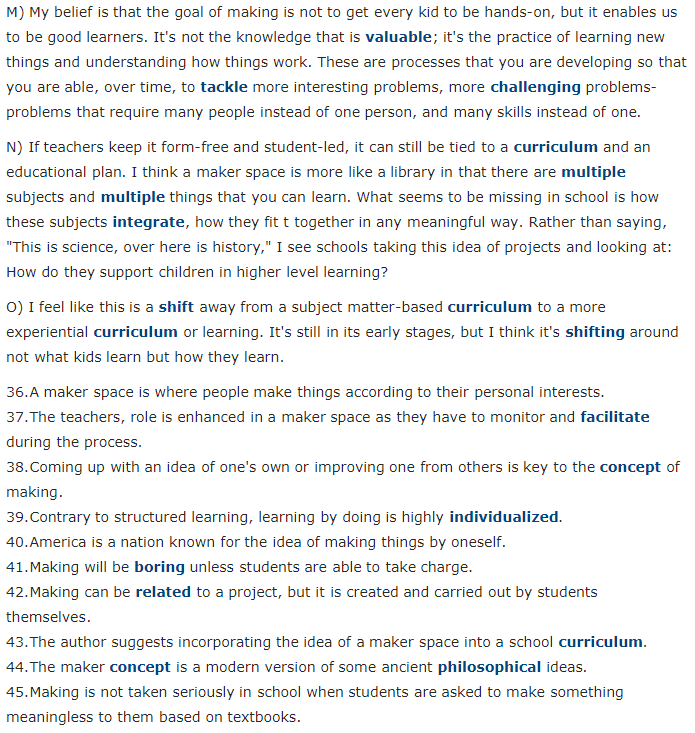
- 查看答案
Professor Ashok Goel of Georgia Tech developed an artificially intelligent teaching assistant to help handle the enormous number of student questions in the online class, Knowledge-Based Artificial Intelligence. This online course is a core requirement of Georgia Tech's online Master of Science in Computer Science program. Professor Goel already had eight teaching assistants, but that wasn't enough to deal with the overwhelming number of daily questions from students.
Many students drop out of online courses because of the lack of teaching support. When students feel isolated or confused and reach out with questions that go unanswered, their motivation to continue begins to fade. Professor Goel decided to do something to remedy this situation and his solution was to create a virtual assistant named Jill Watson, which is based on the IBM Watson platform.
Goel and his team developed several versions of Jill Watson before releasing her to the online forums. At first, the virtual assistant wasn't too great. But Goel and his team sourced the online discussion forum to find all the 40,000 questions that had ever been asked since the class was launched. Then they began to feed Jill with the questions and answers. After some adjustments and sufficient time, Jill was able to answer the students' questions correctly 97% of the time. The virtual assistant became so advanced and realistic that the students didn't know she was a computer. The students, who were studying artificial intelligence, were interacting with the virtual assistant and couldn't tell it apart from a real human being. Goel didn't inform them about Jill's true identity until April 26. The students were actually very positive about the experience.
The goal of Professor Goel's virtual assistant next year is to take over answering 40% of all the questions posed by students on the online forum. The name Jill Watson will, of course, change to something else next semester. Professor Goel has a much rosier outlook on the future of artificial intelligence than, say, Elon Musk, Stephen Hawking, Bill Gates or Steve Wozniak.
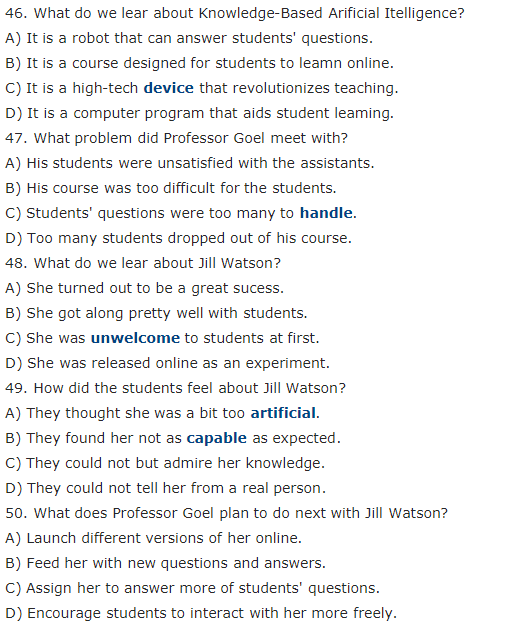
- 查看答案